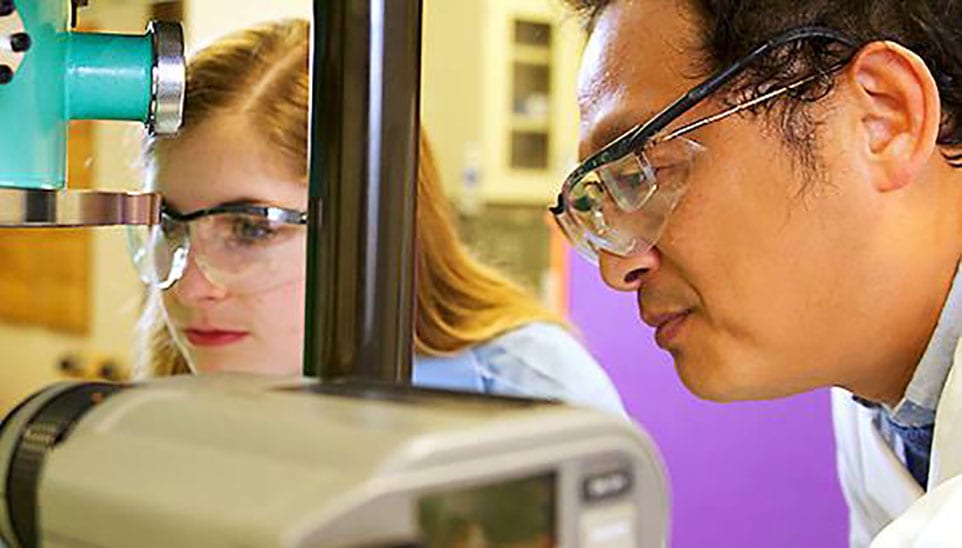
CLEMSON, South Carolina – An international collaboration, a bit of serendipity and a lot of hard work over the past three years has led to a discovery that is set to literally reshape the world of inorganic semiconductor materials.
Clemson University researcher Jian He is a corresponding author on “Exceptional plasticity in the bulk single-crystalline van der Waals semiconductor InSe,” published in a recent issue of the journal Science. Working with teams in China, He coordinated experiments, analyzed data and suggested next steps along the way. He said the interdisciplinary team pushed him beyond his research comfort zone, which lies in materials synthesis and transport measurements.
This research focused on indium selenide (InSe), a van der Waals inorganic semiconductor.
“What we discovered is a new property of an ‘old’ material,” He said, adding that the focus in this instance was on the van der Waals chemical bonds.
Inorganic semiconductors are crucial to modern electronics but almost universally brittle. They tend to lose their structural integrity when bent or twisted, often shattering into pieces. The presence of van der Waals bonding only makes this more of an issue.
“Van der Waals inorganic semiconductors are somewhat like a stack of papers. Each paper stands for a layer of atoms,” said He, an associate professor in the College of Science’s Department of Physics and Astronomy. “Each paper is hard to tear. However, between papers, the van der Waals bonding is weak. It’s easy to detach a layer of paper from the rest.
“But indium selenide, we discovered, is easily deformable without shattering. You can deform the material as if you are dealing with aluminum foil,” He continued. “You can morph it into different shapes at room temperature. The material shows exceptional ability for deformation. That’s the discovery – it’s an old material but an unexpected property.”

Indeed, this was so unexpected that He initially assumed something was amiss, but the science confirmed the discovery. Compared to other van der Waals inorganic semiconductors, the intralayer (within the atomic layer) bonding is weaker with indium selenide, while the interlayer (between the atomic layer) is stronger.
“Because of this peculiar combination that enables interlayer gliding and cross-layer dislocation slip, the material can be deformed to a large degree without losing its structural integrity,” He said.
In fact, the team showed that bulk single crystalline indium selenide can be morphed into simple origami and Mobius ring, which He said he proposed half-jokingly. This opens a world of possibilities, along with more questions to answer. He is looking forward to finding out what lies ahead.
“The honest answer is we do not know the full potential of this discovery yet,” He said. “Time will tell. So far, we can think of several possible applications.”
Among those are the use of indium selenide as an optoelectrical sensor in extreme environments, where most inorganic semiconductors are too brittle to properly function.
“For a deformable material, the function is still there, but it can make the device more robust,” He said.
Energy conversion through wearable or flexible thermoelectric devices is another possibility.
“Of course, we are interested in the functions and properties of a material,” He said. “But in a deeper sense, we are interested in why this material is different, and if we can find another deformable inorganic semiconductor.“
Now, the hunt is on for “the next one.”

“In the paper, we proposed a set of criteria to look for more intrinsically deformable inorganic semiconductors,” He said. “We know where to look.”
In addition to He, other contributors to the paper are Tian-Ran Wei and Xun Shi of Shanghai Jiao Tong University and the Chinese Academy of Sciences, Shanghai; Min Jin and Rongbin Li of Shanghai Dianji University; Yuecun Wang and Zhiwei Shan of Xi’an Jiaotong University; Hongyi Chen, Zhiqiang Gao, Kunpeng Zhao, Pengfei Qiu, Lidong Chen of Chinese Academy of Sciences, Shanghai; Jun Jiang of Chinese Academy of Sciences, Ningbo.
A perspective titled “Ductile van der Waals materials” was published in the same issue of the journal Science to highlight this discovery.
Get in touch and we will connect you with the author or another expert.
Or email us at news@clemson.edu

